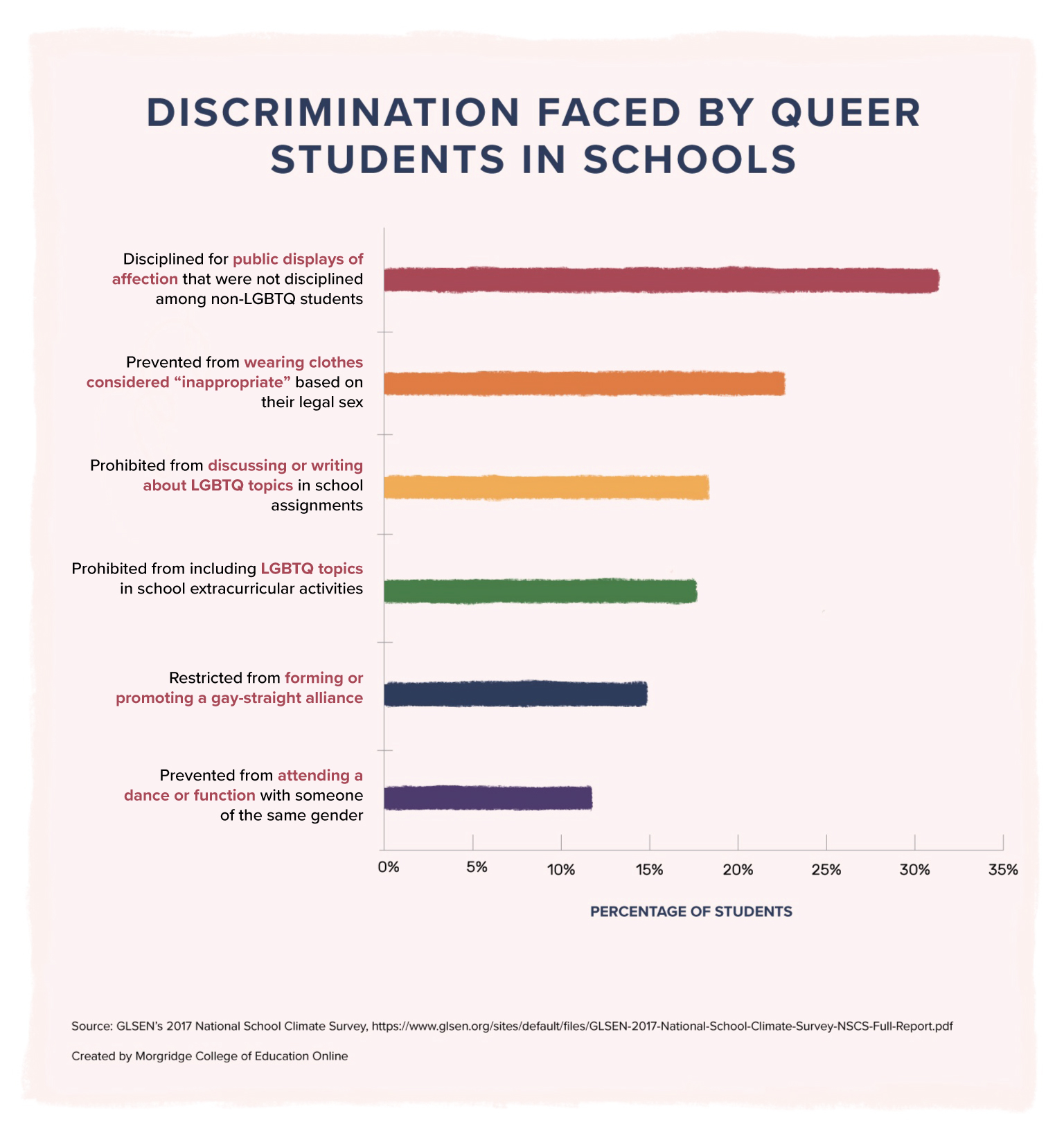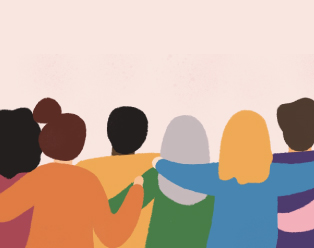What Challenges Do Queer Students Face?

According to GLSEN’s 2017 National School Climate Survey (PDF, 8.4 MB), almost 90% of LGBTQ students experienced harassment or assault based on personal characteristics, including sexual orientation, gender expression, gender, religion, actual or perceived race and ethnicity, and actual or perceived disability. Nearly two-thirds reported experiencing LGBTQ-related discriminatory policies or practices at school.

While every student’s experience is different, queer students face a number of challenges when interacting with their peers, teachers, administrators, parents of their peers, and overall community. Even seemingly small actions like hearing the word “gay” used in a negative way can build up. More than 90% of LGBTQ students said they felt distressed because of this language.
These kinds of challenges pull focus away from learning, which should be the number one priority of every student when they enter school.
“You don’t want students to have to take action toward meeting basic needs of safety and belonging,” said Dr. Stacy Pinto, faculty member for the online master’s in school counseling program at the University of Denver. “They should be moving towards self-actualization, learning and building relationships. They should not be coming to school worrying about whether or not they’re going to be safe or they’re going to be bullied.”
How Can Schools Address Challenges Faced by Queer Students?
Approach the creation of inclusive policy with a goal of allowing students to focus on their education. Inclusive practices require effort and intent and are always going to be evolving. To help students feel comfortable, it’s important to emphasize visibility and make sure they feel seen. Leaders also need to understand privilege and oppression and be cognizant of their own identities, particularly if they identify with the majority. Pinto suggests addressing five major challenges experienced by queer students.
Policy
Develop policy that allows students to express themselves. It should be appropriate, safe, intentional and inclusive.
Consider:
- Does the staff use chosen names and pronouns?
- Does the dress code account for students of all gender expressions?
- Are options for bathrooms, locker rooms, and other traditionally gendered spaces accessible to and safe for students of all gender identities?
- Who are students allowed to bring as guests to dances?
Education
Deliver education in an intentional way that ensures students feel validated and learn what they need to progress in life.
Consider:
- Does health and/or sex education include different reproductive options?
- Is safe sex for nonheterosexual relationships covered?
- Are students learning about queer history, including violence and activism?
- Are students learning about the positive contributions of queer people throughout history?
Representation in Community
Ensure that students see themselves reflected in the place they spend most of their time.
Consider:
- Are different family compositions represented in the visuals throughout the school?
- Are different identities incorporated in lessons and word problems?
- What clubs, organizations and/or affinity groups exist for people who have unique identities, beliefs or interests?
- What other social opportunities can be created for those students?
Bullying
Ensure that students feel safe and have someone to go to when bullying occurs. Bullying has less of an impact on self-esteem when students feel connected to their community.
Consider:
- How can staff undo socialization against queer identities that might have happened at home?
- How can staff educate students to understand that that there isn’t a normal and celebrate differences?
- What actions can be taken to minimize the effects of bullying?
- Do students know where to turn to and feel comfortable asking for help?
Support
Offer opportunities for students to build relationships and have meaningful engagement with the people and systems in their lives.
Consider:
- How can the school provide opportunities for students to build their relationships with their families? The community?
- Is the connection between the student and the school being cultivated?
- What systems are in place for identifying students in need of interpersonal support?
- What systems are in place for meeting students’ needs for interpersonal support?
Remember to elicit feedback from all stakeholders. Provide the opportunity for constant feedback to meet the needs of students in underrepresented groups, as opposed to only acting based on the consensus of the majority. Make sure the voices of queer students are represented in the choices that are made. Feedback can be provided in informal or formal means such as town halls, assemblies, climate surveys and suggestion boxes.
The following section includes tabular data from the graphic in this post.
Discrimination Faced by Queer Students in Schools
GLSEN’s 2017 National School Climate Survey (PDF, 8.4 MB) asked LGBTQ students if they experienced discriminatory school policies or practices.
| Discriminatory Policy or Practice | Percentage of Students |
|---|---|
Disciplined for public displays of affection that were not disciplined among non-LGBTQ students | 31.3% |
Prevented from wearing clothes considered “inappropriate” based on their legal sex | 22.6% |
Prohibited from discussing or writing about LGBTQ topics in school assignments | 18.2% |
Prohibited from including LGBTQ topics in school extracurricular activities | 17.6% |
Restricted from forming or promoting a gay-straight alliance | 14.8% |
Prevented from attending a dance or function with someone of the same gender | 11.7% |
Read the rest of the series

Queer is an umbrella term that represents that everyone is different and that differences should be celebrated. Learn how schools can understand labels.

School counselors can build queer-affirming environments. However, they should recognize the limitations in their knowledge and work to fill those gaps.
Citation for this content: SchoolCounseling@Denver, the online master’s in school counseling program from University of Denver’s Morgridge College of Education.

